Top News
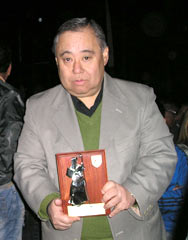
October 6, 2014 Ricardo Oshiro, correspondent of Ryukyu Shimpo
Sixty-year-old second generation Okinawan Argentine doctor Antonio Simon Agarie has received the San Juan Bautista award for community contribution from the City of Florencio Varela, Argentina. The award ceremony was held at Nahuel Club in Florencio Varel.
The San Juan Bautista award is given to a person who contributes to the local community, targeted at those who work for the health service.
Agaries is a second generation Okinawan Argentine from Nago City. He works as a physician for the state hospital and other institutions in Florencio Varela.
Florencio Varela is located 40 kilometers south of Gran Buenos Aires urban area in Buenos Aires Province, with a population of 425,000. The city is known to have many Okinawa Argentines from Nago. The office of the Nago Association of Argentina is located in the city.
(English translation by T&CT)
Go to Japanese
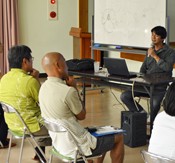
October 5, 2014 Tetsuya Nakajima, correspondent of Ryukyu Shimpo
Los Angeles resident and CGI(Computer-Generated Image) artist Hiroki Itokazu, from Kumejima, took part in creating Disney’s animated film Frozen, which won the Academy Award for the best animated feature film at the 86th Annual Academy Awards. The CGI modeller delivered a lecture at IF Information Plaza in Kumejima Town on September 26. About 50 residents attended Itokazu’s lecture.
After graduating from the University of the Ryukyus, Itokazu moved to the United States to study industrial design. During his speech, he talked about how impressed he was by the students at the school he attended. He said they dedicated themselves to creating 3D computer-animated works, even giving up holidays to continue their work. Itokazu also spoke about what led him to work at the Walt Disney Animation Studios.
Itokazu said, “Making 3D CGI models is a job which requires quiet dedication. We create 3D models based on two-dimensional sketches.” He explained, “In Frozen, we created models based on photographs of the scenery in Norway, where we actually traveled to as part of the making of film.”
The members of the Walt Disney Animation Studios complete their projects after many discussions, in which all the members take part. Although that process takes time, they eventually manage to create excellent movies. Itokazu stressed that they see stories, designs and characters as important.
Itokazu carries out online teaching for 3d modeling to students at Kumejima High School in his hometown every week. He advised, “The number of CGI artists is very high now. Those who want to be 3D artists, need to study hard at high school and college.”
In the question and answer session with the attendees, Itokazu said, “Every time I watch movies, I always analyze the character designs from the view point of a CGI artist. So, I cannot get into the stories.”
(English translation by T&CT)
Go to Japanese
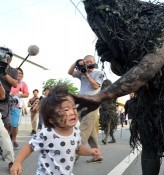
October 4, 2014 Ryukyu Shimpo
A traditional Pantou event, which is designated a significant intangible folk cultural asset of the country, took place in Tairashimajiri district in Miyakojima City on October 3 and 4.
Visiting gods, pantou, dressed in muddy vines, smeared mud on people and houses to drive away evil spirits and pray for perfect health.
Three pantou gods called Nmariga emerged from an old well at 5 p.m., ran around, and came up behind people and smeared mud on them. People screamed in surprise, and could be heard throughout the district.
Asami Nagamine, who took part in the event for the first time, said, “I prayed for good health for my child. I believe he will grow up healthy this year. ” Her three-year-old boy was crying and saying, “I am scared. I will not do any bad thing.”
(English translation by T&CT)
Go to Japanese
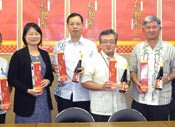
October 1, 2014 Ryukyu Shimpo
Okinawa Ham Co. Ltd. (OkiHam) created “Benikojisu” which consists of rice malt, Ryukyu Moromi Vinegar, and gamma-aminobutyric acid (GABA). Working with the Okinawa Industry Business Association, the company will test-market Benikojisu on wealthy consumers in Taiwan from mid-October to February 2015.
OkiHam used rice malt from Gunze in Tokyo, Ryukyu Moromi Vinegar from Kumesen Brewing Company, and their original GABA.

New product of Okinawa Ham "Benikojisu" to be targeted at wealthy consumers in Taiwan.
The company has developed the product with support from the 2014 Smaller Business Problem Solution Regional Collaboration Project of the Prefectural Industry Promotion Corporation. A 500 millilitre bottle of Benikojisu costs 1,800 Taiwanese dollars, which is about 6,120 Japanese yen. In Japan, one bottle will sell for 3,240 yen, including tax. Through Taiwanese importers, the company will sell the product at 60 to 70 local stores such as pharmacies, department stores, and mass retailers. Its sales target in Taiwan is 6,000 bottles by February 2015. In Okinawa, the company will sell the product at Takarajima, a store belonging to the association. It also plans to make it available at pharmacies and mass retailers in the future. The sales target in Japan is 2,000 bottles.
(English translation by T&CT and Megumi Chibana)
Go to Japanese
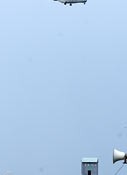
October 1, 2014 Ryukyu Shimpo
Okinawa Governor Hirokazu Nakaima has previously stated that he would work to ease Okinawa’s US military base burden by transferring military training outside of the prefecture and stopping the operation of U.S. Marine Corps Air Station Futenma within five years. However, his plan appears not to be progressing. Also, there are still concerns over the safety of the Osprey.
According to a visual inspection carried out by the Ginowan City Government, the number of Osprey flights amounts to 2,341 over the two years since the aircraft was first stationed in Okinawa in 2012.
While the number was 888 in the first year, when the U.S.military started the training, it increased about 1.64 times to 1,453 in the second year, when the military increased the number of Osprey aircraft stationed in Okinawa to 24.
Even though the military is supposed to limit the number of Ospreys training after 10 p.m., it has been carrying out regular late-night training in recent days.
The Japanese government suggested temporarily transferring Osprey training to Saga Airport. However, the U.S.military expressed reservations about it. The plan is likely to be denied.
(English translation by T&CT)
Go to Japanese
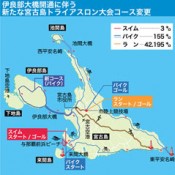
September 26, 2014 Ryukyu Shimpo
A general meeting for the executive committee of the 31st All Japan Triathlon Miyakojima was held in Miyakojima on September 25. The committee decided to hold the competition on April 19 2015 and include the newly-built Irabu Long Bridge in the bike course. The bridge will be open to traffic from January 2015.
The committee has changed the route to include Irabu island, which competitors will go halfway around. Applications opened on October 1.
The 31st All Japan Triathlon Miyakojima will start at 7am on April 19 2015.
The event consists of a three-kilometer swim, a 155-kilometer bicycle ride followed by a 42 kilometer full marathon. The participants start swimming at Yonaha
Maehama beach, and do a full circuit of Miyakojima by bicycle.
At the meeting, the committee announced financial results for the 30th event and decided on a budget for the 31st.
The budget for the 31st event is 95,220,000 yen.
The 30th event was held on April 20 2014. A record number of 3,657 people applied, and 1,531 of them took part. A theme song was created to mark the 30th anniversary of the establishment of the All Japan Triathlon Miyakojima. The Prime Minister Cup was created for the event for the first time in Okinawan sport. A representative of the committee stated, “The event has contributed to the promotion of Miyakojima.”
President of the event Toshihiko Shimoji who is also Maykojima Mayor, said, “The establishment of the Prime Minister Cup reflects the excellence of the All Japan Triathlon Miyakojima. We would like to keep running the event successfully.”
(English translation by T&CT)
Go to Japanese
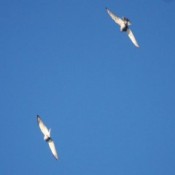
September 24, 2014 Hirokazu Otsubo, correspondent of Ryukyu Shimpo
The Zamami Wild Bird Club members observed Chinese Goshawk birds from a lookout at Mount Takatsuki. The migratory birds, which herald the start of autumn, flew in the sky above the island.
On September 13, one day later than last year, the birds were confirmed to have arrived on the island for the first time this year. They have since been arriving consistently. At least 111 birds were observed on September 20.
In Zamami Village, people have been observing several migratory birds. Further into autumn, locals and visitors will have more opportunities to watch various friendly, wild birds.
(English translation by T&CT, Hitomi Shinzato)
Go to Japanese
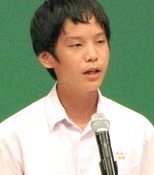
October 1, 2014 Ryukyu Shimpo
On September 30, the Okinawa Prefectural People’s Forum for the Fostering of Children and Youth held the 36th Okinawa Junior Students Speech Contest at the Okinawa Civic Theater Ashibina in Okinawa City.
Twelve contestants selected from six districts in Okinawa voiced their opinions on various issues. The second-grade student of Naha Junior High School Tenyo Takahashi won the Grand Prize. He made a speech on the theme of prejudice. He said it is important to understand each other as individuals, and not make assumptions based on national stereotypes.
The boy’s parents are from China. He has experienced prejudice at elementary schools in Japan and China, where he noticed that other students saw him as different. As an example of prejudice, he raised the issue of Japanese websites which slander Chinese people. Takahashi said, “Japanese and Chinese people are the same human beings. Each person has a personality. It is important that we should interact with many people who are different from us and understand each other deeply, because we are the generation who will support the future society.”
His manuscript and audio tape will be sent to a speech contest in Kyushu. The top two winners in Kyushu can take part in a national competition.
The list of other winners follows:
Excellence Award Ryota Shiroma (second-grade student of Nishihara Junior High School), Moeka Nishino (second-grade student of Yokatsu-midorigaoka Junior High School)
Special Jury Prize Kyoka Nakamura (third-grade student of Kamimotobu Junior High School)
(English translation by T&CT)
Go to Japanese
September 23, 2014 Ryukyu Shimpo
Flights between Seoul and Naha will increase to five round trips daily by the end of this year. Korean LCC Jeju Air will launch a round trip on the route every day from December 1, and T’way Airlines will do the same from December 25. It will be the first time Jeju Air has operated flights between Seoul and Naha. In addition to this, Jin Air, which is currently running flights on the route, will increase flights to two round trips a day from October 26.
Jeju Air uses the 189-seater Boeing 738. Tway Airlines uses the same airplane in a 186-seat configuration. Jin Air uses the 180-seater Boeing 737-800.
Seijun Wakugawa of the Okinawa Prefectural Government (OPG) said, “Okinawa aims to make Naha Airport a hub airport. We welcome airlines launching new routes. We would like to promote use of increased flights on this route. To support tourism exchange, we hope many Okinawans will visit Korea too.”
According to the OPG’s statistics, the number of Korean tourist arrivals in 2013 was 98,400, which was 2.2 times that of the previous year. The rising trend followed into 2014, as arrivals between April and August rose 64.9 percent to 51,600 compared to the same period last year.
(English translation by T&CT and Lima Tokumori)
Go to Japanese
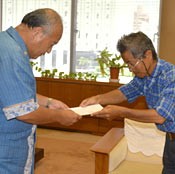
September 29, 2014 Ryukyu Shimpo
Takamatsu Gushiken, the president of the Gamafuya, a volunteer group dedicated to the recovery of remains of the Battle of Okinawa, visited the Okinawa Prefectural Assembly on September 25. Gushiken asked Masaharu Kina, the chairman of the assembly, to reassess the application for landfill off the coast of Henoko, Nago. Okinawa Governor Hirokazu Nakaima has approved the Japanese government’s application for landfill at Henoko in preparation for relocating the U.S. Marine Corps Air Station Futenma. Gushiken pointed out it is possible there are many remains of Battle of Okinawa victims within the Camp Schwab site where the construction of a new U.S.military base is being carried out. He claimed the Okinawa Prefectural Government (OPG) did not take account of this when reviewing the application, which he said was a huge mistake.
During the Battle of Okinawa, many residents died of malnutrition and were buried at camps around the island. It is possible that one of these camps was Ourazaki camp within the Camp Schwab site. Gushiken claimed, “There is a high possibility the site has many remains, which have not been recovered.”
He said, “I want the Japanese government to stop the construction (at Henoko) and ensure any remains there are preserved. Building the military base over the deceased is disrespectful. The OPG, which has a duty to carry on the memory of the war, should not allow the construction.”
Kina said, “I imagine the victims of the war would have asked Gushiken to seek reassessment of the application. We would like to take it seriously.”
(English translation by T&CT)
Go to Japanese
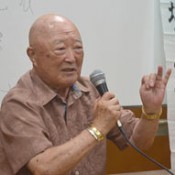
September 29, 2014 Ryukyu Shimpo
A lecture targeted at middle-aged to elderly people with an interest in Okinawa food history was held at Kitanakagusuku Ogusuku community center on September 25. Kenichi Dohi, the president of major Okinawa Soba maker Sun Foods Co., Ltd. and top adviser of the Okinawa Fresh Noodles Cooperative delivered a lecture about Okinawa Soba.
Dohi is from Kumamoto Prefecture. He visited Okinawa before its reversion to Japanese sovereignty, and founded Sun Foods Co. in Naha in 1968.
He told the story of how he opened up a store in the basement of what was the Okinawa Mitsukoshi department store, and how he worked hard to sell noodles year-around. The audience listened to Dohi speak about his work to promote the noodle.
The Japan Fair Trade Commission did not originally allow Okinawa Soba to use the word Soba in its name because the noodle does not contain buckwheat flour. As a member of the cooperative, Dohi made efforts to preserve the name of the noodle.
After many negotiations in Tokyo, in 1978, the cooperative and other organizations managed to get the commission to give permission to use the name Okinawa Soba. Dohi said, “I managed to get government officials to visit Okinawa and taste the noodle. I also went overseas and collected the documents related to the origin of Okinawa Soba.”
While trying to automate the manufacturing of the noodle, Dohi aims to produce and ship 700,000 to 800,000 packets every day.
He plans to represent the cooperative in Expo Milano 2015, which will be held in Italy next May. Do concluded, “Pasta took 400 years to become popular worldwide. We have airplanes now. Within the next 40 years, Okinawa Soba will become popular worldwide.”
(English translation by T&CT)
Go to Japanese











 Webcam(Kokusai Street)
Webcam(Kokusai Street)


